|
The
Importance of Good Lighting
Back in 2010 I wrote a short
article for the newsletter on the
importance of lighting and I'd
like to revisit the topic and
expand on it. So much has changed
in 6 years in the lighting world,
especially in needlework. At that
time the best lamp you could buy
for needlework was a Holtkötter
Halogen lamp, which for its time
was fabulous (and one of the few
dim-able Halogoen lamps). We
wouldn't have considered using an
LED lamp as anything other than
accent lighting. The technology
hadn't matured enough to be
mainstream and products like the
great LED lamps from Stella
Lighting were just a
twinkle in someone's eye. The
first generation of LED lamps from
Mighty Bright and others were
good, but as time has marched on
we're getting better power and
color from LED technology that has
matched or exceeded the tried and
true Incandescent or Florescent
bulbs.
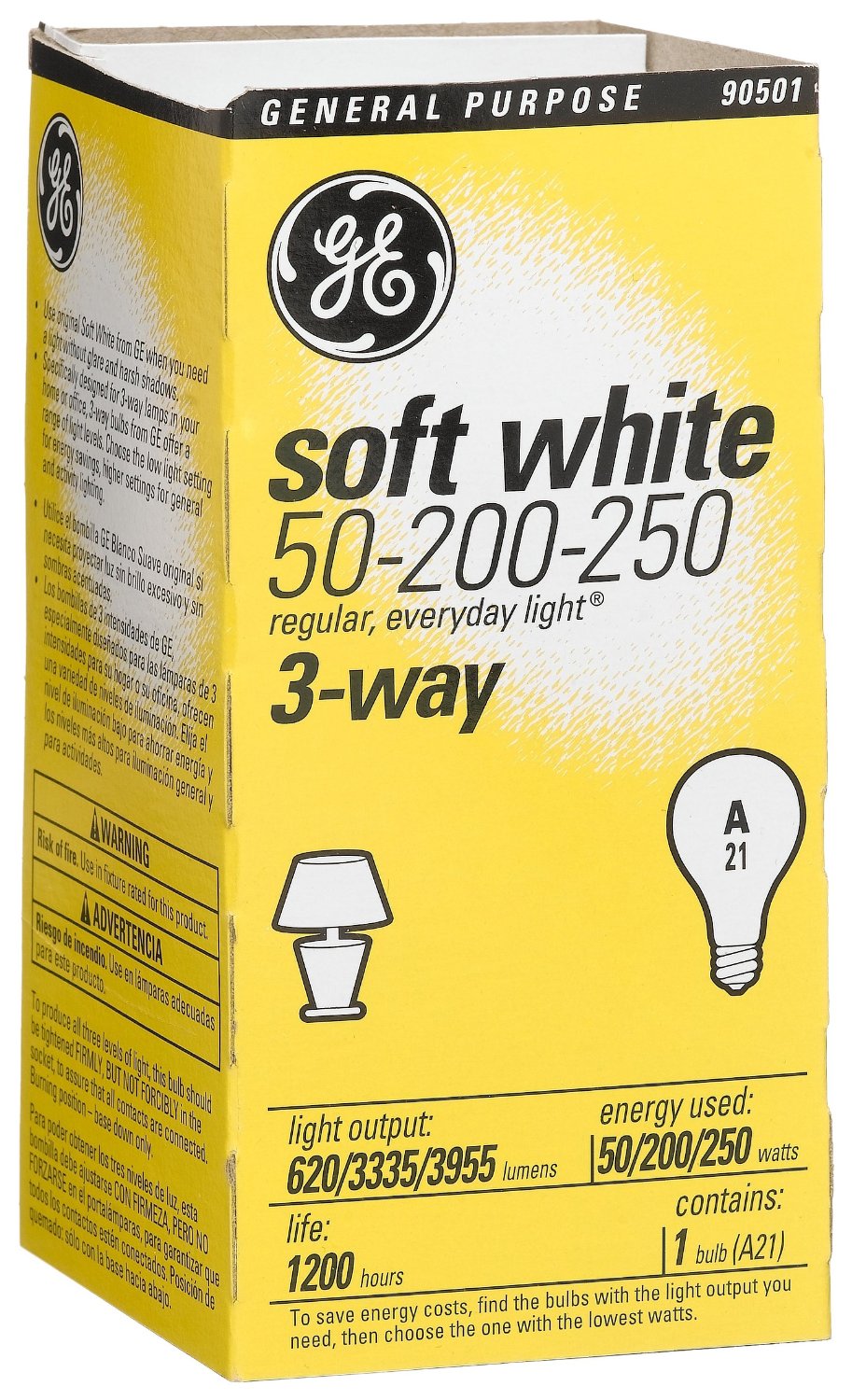 Many
customers ask me how it is that I
can stitch so easily on 40 count
linen over one and 45 and up
counts, especially given I reached
my 6th decade in 2015. I don't use
additional magnification for this.
I'll talk about my progressive
lenses next time when I cover
magnification. But the primary
reason is I stitch with very
strong light. And I do mean strong
- I use with a 50/200/250 Watt
incandescent bulb or my Stella
Edge. When I'm watching
TV or typing on my laptop, I use
the 50 watt setting. But when I
stitch, I put it on 200 or 250
setting or use my Stella.
My husband has been known to
pretend to be blinded by either -
but he's really a mushroom anyway
so we'll skip over that part :-).
With my  Stella Stella Edge
I have it set on the color setting
that's the combination of both the
colored LEDs (classified as
Natural) and the 2nd setting from
the bottom (~285 lumens). So not
as bright for my my incandescent
bulb, in part because the lamp is
closer to me and it's a "clearer"
light. The joy of the Stella
is that LEDs generate
very, very little heat. I don't
use both an incandescent bulb and
the Stella, I
only use one or the other.
As we get older one of things
that diminishes in our eyes is
light vs. dark contrast. And it's
that contrast that helps us see
the holes in the fabric. So having
a brighter light helps offset some
of that loss of contrast. I've
worn glasses since I was six while
my husband only started wearing
them about 10 years for computer
work. Even before that he couldn't
understand how I could see tiny
print in not well lighted
situations when with 20/20 vision
he couldn't. In the end we decided
it was that my eyes could better
detect the contrast than his
could. Still true today when he's
trying to read the recycling
symbols on various packaging and I
can read it just fine.
Do
I need better light?
How do you know if you need
better light? My first question to
any customer for this is: Can you
see to stitch outside in direct
sunlight? If the answer is yes,
then light is a big chunk of your
problem and solution. That doesn't
mean that you might not need
additional magnification,
especially if you have other
vision issues. But that simple
"test" will get you a long way
toward understanding what the
problem is you're trying to solve.
What I recommend after that
illuminating moment is that you
purchase a higher wattage
incandescent bulb to try out in
your usual stitching spot. If
you're just doing a test chances
are you're not going to melt the
wiring in your lamp or cause your
shade to burn up. If you do decide
on a higher wattage incandescent
as your solution you do need to do
a few more things, which I'll
cover below. If you choose a
different type of lamp as a
solution then you don't need to
worry about the same issue.
What
type of light do I need -
general or task?
My all time favorite question
from my days as a software
engineer is the sentence I had
earlier: What problem are you
trying to solve? Understanding
your lighting problem will help
toward the right solution. It's
one of the reasons I ask people to
do the sunlight test when they ask
about magnification as well.
Knowing your problem is the first
step.
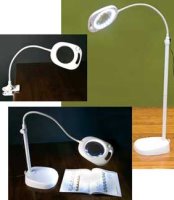 Are
you trying to get more general
light? By this I mean, you're
after a better overall lighted
area vs. task lighting. My
incandescent bulb solution solves
my general lighting problem. I
want to be able to read my chart
or instructions as well as see my
stitching (or beading as the case
may be). So I want a wider area
illuminated as good as I can get
it - without blinding the
neighbors (my husband can fend for
himself :-)). If I'm working from
my iPad as the source for my
pattern or doing needlepoint I
don't need general lighting as
much, I need more task lighting.
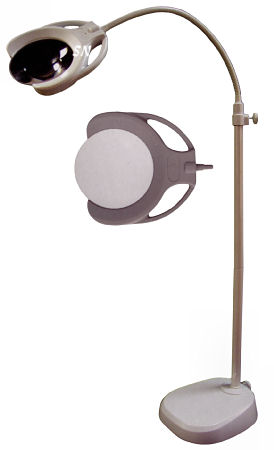 Do
you have ok general lighting but
need more task lighting? Task
lighting is usually concentrated
lighting, regardless of how bright
it is. At the low end of task
lighting are the little clip-on
lamps that are more like tiny spot
lights. At the higher end of task
lighting are the Stella lamps,
which offer a wider area and
varying degrees of brightness. In
between are the older generation
of Florescent (usually about 50-75
watt equivalent - e.g. Dazor,
Ott-Lite, etc.) as well as the
newer LED lights. One of the
pieces of information missing with
LED lights is that they don't
usually give you watt equivalents
or even Lumens, so it's really
hard to gauge just how bright they
are.
For decent task lighting Craftlite's
Dublin or Brighton lamps work, are
portable and have a built in
magnifier. Ottlite and
Daylight also
make lamps with 20-30 LEDs that
have pretty decent task lighting
(Foldi & D20 from Daylight).
Stella lamps
provide excellent task lighting,
with a broad enough area that they
can provide some general lighting
as well.
Being clear about you lighting
need will reduce the chances of
you being disappointed. When I
have this conversation in person
with people I would say 60% of the
time people are moderately
disappointed that they can't get
by with just their "craft" light
(whatever the brand) because they
expected to be able to have it
cover a wider area. Task lighting
is only part of the overall
lighting solution. It can give you
the extra oomph you need, but it's
not always the entire solution. It
depends on the lamp and your use
of it.
LED
Lighting
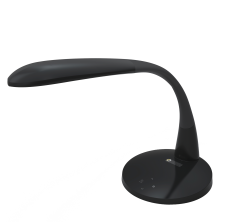 I
know this is going to sound like
shameless marketing, but I love my
Stella lamp.
It's the first task lamp that I've
found that gives me enough light
to not need better general
lighting at the same time. So it's
fabulous for hotel rooms, friends
houses and class rooms. 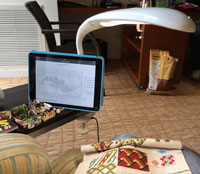 There
are other brands on the market now
that are going after the high end
task lighting market but I still
think Stella is
the best. I've been known to take
my Needlework System 4
Travel Mate along on a trip just
so I have something to clamp my Stella
to, unless I know I might
have a table to use as in the
photo at right. This week I
purchased 24 of the Stella
Desk lamps for class use as we
start doing our weekend events at
the local hotel. You know I like
something when I'm willing to
spring for that many of them!
Whether you pick a high-end
lamp light like a Stella
or something more
moderately priced like a Dublin,
Brighton or Daylight D20,
see if you can try it first to
ensure it will help solve your
problem. You don't want to spend
money on something that won't help
you. This is especially important
with LED lamps since as I noted
above, it's rare to find the
technical specs so you can
determine how bright they are. For
this article I tried tracking down
the Lumens for Stella,
CraftLite Dublin
and Brighton, and the 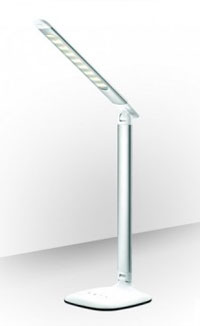 Daylight Daylight's
D20 and Foldi. I was able to
obtain the Stella specs
(127 to 1410 Lumens depending on
the setting) and find the Lux
rating for the Daylight (900
& 930). But mapping Lux to
Lumens isn't something I have
figured out, even with finding the
math formula. I'm hoping someone I
know who's an expert in this can
help me sort it out. And then I'll
post that info later.
LEDs don't blow out like
regular bulbs, they fade over
time, eventually dying. However
that time is 35,000- 50,000 hours
so longer than many of us will be
stitching. As they lose their
luminescence they dim vs. just
fail or flicker. If you have an
LED lamp that uses batteries,
you'll get this affect as the
batteries lose their power. The
bulbs will dim. Just put in new
batteries or recharge the lamp's
internal battery. LEDs are
generally not replaceable as they
are hardwired into the lamp
mechanism in a whole different
way. As far as I can find most
LEDs used in these types of lamps
have a Color Rendition Index (CRI)
around 80, which is decent for
what we need. Finding anything
over that in an LED is really
difficult - maybe eventually
they'll get there.
Florescent
Lamps
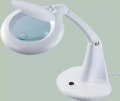 Typically
these are rated around 75-100
watts and come either in U shape
or round. But with the advent of
LEDs many of the florescent lamps
are being phased out both due to
concerns about the gasses in the
bulbs as well as the lower cost
now of LEDs, both to produce and
to run them. I personally don't
use CFLs in my house except in
very specific places, in part
because finding bright CFLs is
harder than incandescent. I
understand the need to conserve
power, but I'm conserving my
eyeballs! I do use CFLs or LED
bulbs in places where I don't need
as bright a light (like my porch)
and I don't want to replace them
often. But I don't use CFLs for
stitching.
At the shop we use florescent
bulbs in the overhead fixtures but
we use a higher wattage (54W) with
a color of 5,200K and CRI of 92.
You almost never find all 3 of
those ratings for task lamps but
occasionally you do. For color
matching anything between 5,000K
and 5,500K is good. Once you get
above 5,900K the light starts to
look blue and throws the colors
off. If you can find the CRI for
the lamp or bulbs you want
something at least 80, but 90 is
better for stitching.
Many of you will be familiar
with Dazor,
which was the premium florescent
task light company for many, many
years. They are still primarily a
producer of florescent lamps, many
with integrated magnifiers used in
jewelry work, component work, etc.
They are not common for needlework
anymore in part because none of
the needlework distributors sell
them any more. Dazor started
selling direct and that made it
harder for both our distributors
and us to compete.
Incandescent
Bulbs for General Lighting
If you use my incandescent
method you need to make sure your
lamp can handle that much heat. A
200 or 250 Watt bulb generates a
lot of heat, way more than a 100
watt does. This means your lamp
has to have reasonably heavy
wiring and you may need a larger
harp and/or lamp shade. I have a Stiffel
floor lamp that's next to
the couch, which is where I do
most of my stitching. I didn't
have to get the lamp rewired but I
did buy a larger harp (the thing
that holds the lamp shade on and
away from the bulb) and I got a
wider lamp shade made of only
fabric (no plastic) to dissipate
the heat. You really don't want
the bulb burning up the inside of
the lamp shade! We have a great
lamp shade store here in Alameda (Carole
Chan's on Encinal) and
I took the lamp with me to find a
new shade & harp eons ago.
Carole's daughter (who does a
little stitching herself) and I
had a fine time taking the shades
for a spin. If you've got a local
store with good people, talk to
them about shades, harps and
re-wiring.
I travel with a 200 watt
incandescent bulb in my luggage
and I swap out the hotel bulb(s)
for a 200 watt so I can stitch in
a hotel room, which are
notoriously under lighted. I do
take my Stella Edge
sometimes as well, but the 200
watt bulb fits great in my
carry-on.
Where
do I position my lamp?
If you sit at a table or desk,
typically you want the lamp in
front of you. This is also true if
you use a Needlework
System 4 floor stand
and attach a lamp to the light
holder. Position it so that while
stitching your hands don't break
the light pool too much(the area
the light spills onto). When you
get shadows it can make seeing
more difficult, even with a lamp.
You might be able to position it
to one side, but it depends on the
lamp and your working area.
If you use a floor stand to
attach your lamp to, you'll need
to play with where to place it,
since you're trying to optimize
both the lamp location and the
stand that's holding your work.
It'll take a bit of trial and
error to find what works and it
can be different for each
stitching area. Some floor stands
like the NS4, hold your work in
front of you, others to one side.
Don't hesitate to experiment.
If you use an incandescent
floor lamp it should be on the
side opposite your dominant
stitching hand. Since I'm
right-handed I have the lamp on my
left. For my regular incandescent
lamp (which is for general
lighting) it's just to left and
behind my shoulder. For my Stella
Edge it's clamped to my
couch arm just to left of where my
wrist would be if my arm was on
the couch arm. This way it's
positioned about the center of my
stitching area. You also want the
height adjusted so you don't get
blinded if you look at the lamp.
Since my floor lamp is height
adjustable I have it set so that
the bottom of the shade is just
above my eye level, that way I
don't look into the bulb directly
when I face the lamp to change its
settings. For task lighting you
need to figure out where the
optimal distance is for the best
coverage. Generally it's about 12"
from the bottom of the bulbs, but
can be up to 18" for brighter
lamps (or the 200 watt
incandescent bulb).
What
brand or type do I choose?
Personal preference can also
dictate which type or brand you
want. Given the energy efficiency
of the current generation of LED
based lamps, I think it's the best
option. You do pay more for them
initially, but the energy use as
well as low level of heat
generation and long life are the
things that put them at the top of
my list.
Here are some handy notes for
the lights we sell (although I did
list incandescent bulbs, which we
don't). This is an alphabetical
listing vs. preference.
| Brand |
Type of Lighting |
Color |
Type of lamp |
Notes |
| Incandescent Bulb |
General |
Single color: Soft
White, Bright White, etc.
based on the bulb type
|
any regular lamp |
least energy
efficient, can be very warm
with higher wattage |
| Craftlite Dublin |
Task - LED |
Single color |
Floor or desk/table |
energy efficient &
has a battery pack. Built in
magnification |
| Craftlite
Brighton |
Task - LED |
3 color: warm, natural
& bright white |
Floor or desk/table |
energy efficient with
rechargeable battery. Also
has a dimmer. |
| Craftlite Dorset |
Task - Florescent |
Single color |
Desk/Table |
circular florescent
bulb. Built in
magnification. |
| Daylight D20 |
Task - LED |
3 color: warm, natural
& bright white |
Desk/Table |
energy efficient, 5
step dimmer |
| Daylight Foldi |
Task - LED |
Single color: bright
white |
Desk/Table |
energy efficient,
battery powered |
| Stella Sky,
Edge & Desk |
Task - LED |
3 color: warm, natural
& bright white |
Floor, desk or table
depending on model |
energy efficient, 5
step dimmer. Excellent for
those with low vision
problems. |
While we used to carry a lot of
Ottlite products,
our distributors stopped carrying
them as Ottlite started
selling direct and as they did
more products that were sold in
stores like JoAnn's (some made
specifically for them). We can't
compete on pricing with JoAnn's,
certainly not when someone has a
40% off coupon which puts the
retail price at what we pay for
it. They do make very good lamps
which you can purchase directly or
at a craft store. MightyBright
still makes a number of
smaller travel oriented lights,
which we can special order.
For a more in-depth review of
the Stella lights
you can read the review I did in
2014 on our blog
or a review on Sew
We Stitch as well as Mary
Corbett's blog. You can find
out more about the individual
lights from the manufacturers
websites.
Now go forth & stitch - and
try not to blind your family
members - or stitch them some eye
shades!
Happy Stitching,
Cathe (January 2016)
|